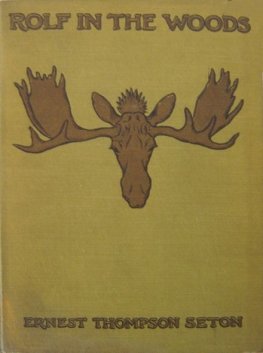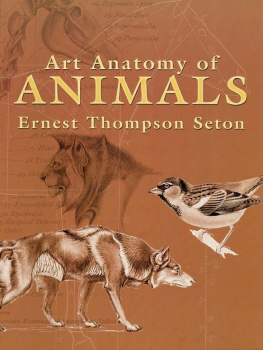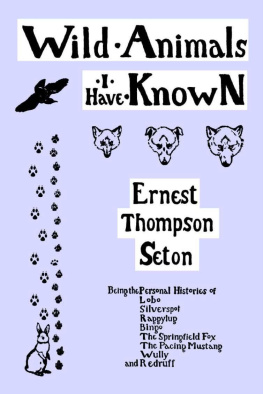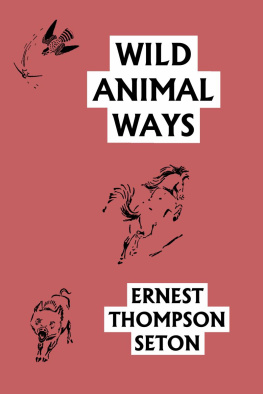Ernest Seton - Wild Animals at Home
Here you can read online Ernest Seton - Wild Animals at Home full text of the book (entire story) in english for free. Download pdf and epub, get meaning, cover and reviews about this ebook. year: 2009, genre: Science. Description of the work, (preface) as well as reviews are available. Best literature library LitArk.com created for fans of good reading and offers a wide selection of genres:
Romance novel
Science fiction
Adventure
Detective
Science
History
Home and family
Prose
Art
Politics
Computer
Non-fiction
Religion
Business
Children
Humor
Choose a favorite category and find really read worthwhile books. Enjoy immersion in the world of imagination, feel the emotions of the characters or learn something new for yourself, make an fascinating discovery.

- Book:Wild Animals at Home
- Author:
- Genre:
- Year:2009
- Rating:4 / 5
- Favourites:Add to favourites
- Your mark:
- 80
- 1
- 2
- 3
- 4
- 5
Wild Animals at Home: summary, description and annotation
We offer to read an annotation, description, summary or preface (depends on what the author of the book "Wild Animals at Home" wrote himself). If you haven't found the necessary information about the book — write in the comments, we will try to find it.
Wild Animals at Home — read online for free the complete book (whole text) full work
Below is the text of the book, divided by pages. System saving the place of the last page read, allows you to conveniently read the book "Wild Animals at Home" online for free, without having to search again every time where you left off. Put a bookmark, and you can go to the page where you finished reading at any time.
Font size:
Interval:
Bookmark:
WILD ANIMALS AT HOME
by Ernest Thompson Seton

I. A Prairie-dog town
In N. Y. Zoo. Photo by E. T. Seton
Foreword
My travels in search of light on the "Animals at Home" have taken me up and down the Rocky Mountains for nearly thirty years. In the canyons from British Columbia to Mexico, I have lighted my campfire, far beyond the bounds of law and order, at times, and yet I have found no place more rewarding than the Yellowstone Park, the great mountain haven of wild life.
Whenever travellers penetrate into remote regions where human hunters are unknown, they find the wild things half tame, little afraid of man, and inclined to stare curiously from a distance of a few paces. But very soon they learn that man is their most dangerous enemy, and fly from him as soon as he is seen. It takes a long time and much restraint to win back their confidence.
In the early days of the West, when game abounded and when fifty yards was the extreme deadly range of the hunter's weapons, wild creatures were comparatively tame. The advent of the rifle and of the lawless skin hunter soon turned all big game into fugitives of excessive shyness and wariness. One glimpse of a man half a mile off, or a whiff of him on the breeze, was enough to make a Mountain Ram or a Wolf run for miles, though formerly these creatures would have gazed serenely from a point but a hundred yards removed.
The establishment of the Yellowstone Park in 1872 was the beginning of a new era of protection for wild life; and, by slow degrees, a different attitude in these animals toward us. In this Reservation, and nowhere else at present in the northwest, the wild things are not only abundant, but they have resumed their traditional Garden-of-Eden attitude toward man.
They come out in the daylight, they are harmless, and they are not afraid at one's approach. Truly this is ideal, a paradise for the naturalist and the camera hunter.
The region first won fame for its Canyon, its Cataracts and its Geysers, but I think its animal life has attracted more travellers than even the landscape beauties. I know it was solely the joy of being among the animals that led me to spend all one summer and part of another season in the Wonderland of the West.
My adventures in making these studies among the fourfoots have been very small adventures indeed; the thrillers are few and far between. Any one can go and have the same or better experiences to-day. But I give them as they happened, and if they furnish no ground for hair-lifting emotions, they will at least show what I was after and how I went.
I have aimed to show something of the little aspects of the creatures' lives, which are those that the ordinary traveller will see; I go with him indeed, pointing out my friends as they chance to pass, adding a few comments that should make for a better acquaintance on all sides. And I have offered glimpses, wherever possible, of the wild thing in its home, embodying in these chapters the substance of many lectures given under the same title as this book.
The cover design is by my wife, Grace Gallatin Seton. She was with me in most of the experiences narrated and had a larger share in every part of the work than might be inferred from the mere text.
Ernest Thompson Seton.
I
The Cute Coyote
AN EXEMPLARY LITTLE BEAST, MY FRIEND THE COYOTE
If you draw a line around the region that is, or was, known as the Wild West, you will find that you have exactly outlined the kingdom of the Coyote. He is even yet found in every part of it, but, unlike his big brother the Wolf, he never frequented the region known as Eastern America.
This is one of the few wild creatures that you can see from the train. Each time I have come to the Yellowstone Park I have discovered the swift gray form of the Coyote among the Prairie-dog towns along the River flat between Livingstone and Gardiner, and in the Park itself have seen him nearly every day, and heard him every night without exception.

Coyote (pronounced Ky-o'-tay, and in some regions Ky-ute) is a native Mexican contribution to the language, and is said to mean "halfbreed," possibly suggesting that the Coyote looks like a cross between the Fox and the Wolf. Such an origin would be a very satisfactory clue to his character, for he does seem to unite in himself every possible attribute in the mental make-up of the other two that can contribute to his success in life.
He is one of the few Park animals not now protected, for the excellent reasons, first that he is so well able to protect himself, second he is even already too numerous, third he is so destructive among the creatures that he can master. He is a beast of rare cunning; some of the Indians call him God's dog or Medicine dog. Some make him the embodiment of the Devil, and some going still further, in the light of their larger experience, make the Coyote the Creator himself seeking amusement in disguise among his creatures, just as did the Sultan in the "Arabian Nights."

The naturalist finds the Coyote interesting for other reasons. When you see that sleek gray and yellow form among the mounds of the Prairie-dog, at once creating a zone of blankness and silence by his very presence as he goes, remember that he is hunting for something to eat; also, that there is another, his mate, not far away. For the Coyote is an exemplary and moral little beast who has only one wife; he loves her devotedly, and they fight the life battle together. Not only is there sure to be a mate close by, but that mate, if invisible, is likely to be playing a game, a very clever game as I have seen it played.
Furthermore, remember there is a squealing brood of little Coyotes in the home den up on a hillside a mile or two away. Father and mother must hunt continually and successfully to furnish their daily food. The dog-towns are their game preserves, but how are they to catch a Prairie-dog! Every one knows that though these little yapping Ground-squirrels will sit up and bark at an express train but twenty feet away, they scuttle down out of sight the moment a man, dog or Coyote enters into the far distant precincts of their town; and downstairs they stay in the cyclone cellar until after a long interval of quiet that probably proves the storm to be past. Then they poke their prominent eyes above the level, and, if all is still, will softly hop out and in due course, resume their feeding.
THE PRAIRIE-DOG OUTWITTED

This is how the clever Coyote utilizes these habits. He and his wife approach the dog-town unseen. One Coyote hides, then the other walks forward openly into the town. There is a great barking of all the Prairie-dogs as they see their enemy approach, but they dive down when he is amongst them. As soon as they are out of sight the second Coyote rushes forward and hides near any promising hole that happens to have some sort of cover close by. Meanwhile, Coyote number one strolls on. The Prairie-dogs that he scared below come up again. At first each puts up the top of his head merely, with his eyes on bumps, much like those of a hippopotamus, prominent and peculiarly suited for this observation work from below, as they are the first things above ground. After a brief inspection, if all be quiet, he comes out an inch more. Now he can look around, the coast is clear, so he sits up on the mound and scans his surroundings.
Font size:
Interval:
Bookmark:
Similar books «Wild Animals at Home»
Look at similar books to Wild Animals at Home. We have selected literature similar in name and meaning in the hope of providing readers with more options to find new, interesting, not yet read works.
Discussion, reviews of the book Wild Animals at Home and just readers' own opinions. Leave your comments, write what you think about the work, its meaning or the main characters. Specify what exactly you liked and what you didn't like, and why you think so.




